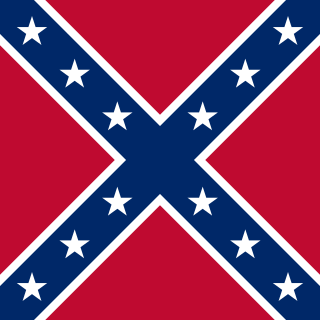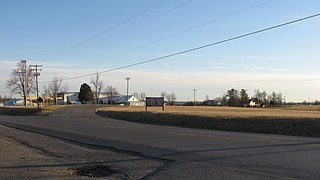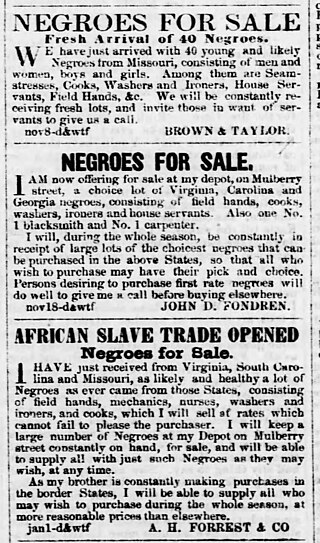
Nathan Bedford Forrest was a 19th-century American slave trader active in the lower Mississippi River valley, a Confederate States Army general during the American Civil War, and the first Grand Wizard of the Reconstruction-era Ku Klux Klan, serving from 1867 to 1869.

The Battle of Brice's Cross Roads, also known as the Battle of Tishomingo Creek or the Battle of Guntown, was fought on Friday, June 10, 1864, near Baldwyn, Mississippi, then part of the Confederate States of America. A Federal expedition from Memphis, Tennessee, of 4,800 infantry and 3,300 cavalry, under the command of Brigadier-General Samuel D. Sturgis, was defeated by a Confederate force of 3,500 cavalry under the command of Major-General Nathan B. Forrest. The battle was a victory for the Confederates. Forrest inflicted heavy casualties on the Federal force and captured more than 1,600 prisoners of war, 18 artillery pieces, and wagons loaded with supplies. Once Sturgis reached Memphis, he asked to be relieved of his command.

James Harrison Wilson was an American military officer, topographic engineer and a Major General in the Union Army during the American Civil War. He initially served as an aide to Major General George B. McClellan during the Maryland Campaign before joining Major General Ulysses S. Grant's army in the Western Theater, where he was promoted to brigadier general. In 1864, he transferred from engineering to the cavalry, where he displayed notable leadership in many engagements of the Overland Campaign. However, his attempt to destroy Lee’s supply lines failed when he was routed by a much smaller force of Confederate irregulars.

Grierson's Raid was a Union cavalry raid during the Vicksburg Campaign of the American Civil War. It ran from April 17 to May 2, 1863, as a diversion from Maj. Gen. Ulysses S. Grant's main attack plan on Vicksburg, Mississippi.

Benjamin Henry Grierson was a music teacher, then a career officer in the United States Army. He was a cavalry general in the volunteer Union Army during the Civil War and later led troops in the American Old West.

The Battle of Fort Pillow, also known as the Fort Pillow Massacre, was fought on April 12, 1864, at Fort Pillow on the Mississippi River in Henning, Tennessee, during the American Civil War. The battle ended with Confederate soldiers commanded by Major General Nathan Bedford Forrest massacring Union soldiers attempting to surrender. Military historian David J. Eicher concluded: "Fort Pillow marked one of the bleakest, saddest events of American military history."

The Battle of Selma was fought on April 2, 1865 in Dallas County, Alabama during the American Civil War. It was part of the Union campaign through Alabama and Georgia, known as Wilson's Raid, in the final full month of the Civil War.
The Battle of Johnsonville was fought November 4–5, 1864, in Benton and Humphreys counties, Tennessee, during the American Civil War. Confederate cavalry commander Major General Nathan Bedford Forrest culminated a 23-day raid through western Tennessee by attacking the Union supply base at Johnsonville. Forrest's attack destroyed a total of 28 Union boats and barges in the Tennessee River and millions of dollars of supplies, disrupting the logistical operations of Union Major General George H. Thomas in Nashville. As a result, Thomas's army was hampered in its plan to defeat Confederate Lieutenant General John Bell Hood's invasion of Tennessee, known as the Franklin–Nashville campaign.
The First Battle of Murfreesboro was fought on July 13, 1862, in Rutherford County, Tennessee, as part of the American Civil War. Troops under Confederate cavalry commander Brig. Gen. Nathan Bedford Forrest surprised and quickly overran a Federal hospital, the camps of several small Union units, and the jail and courthouse in Murfreesboro, Tennessee. All of the Union units surrendered to Forrest, and the Confederates destroyed much of the Union's supplies and destroyed railroad track in the area. The primary consequence of the raid was the diversion of Union forces from a drive on Chattanooga.

Andrew Jackson Smith was a United States Army general during the American Civil War, rising to the command of a corps. He was most noted for his victory over Confederate General Stephen D. Lee at the Battle of Tupelo, Mississippi, on July 14, 1864.
The Battle of Paducah was fought on March 25, 1864, during the American Civil War. A Confederate cavalry force led by Maj. Gen. Nathan Bedford Forrest moved into Tennessee and Kentucky to capture Union supplies. Tennessee had been occupied by Union troops since 1862. He launched a successful raid on Paducah, Kentucky, on the Ohio River.

Edmund Winchester Rucker was a Confederate officer during the American Civil War. After the war he became an industrial leader of Birmingham, Alabama. Fort Rucker - now Fort Novosel, in Alabama was previously named in his honor.
The Battle of Okolona took place on February 22, 1864, in Chickasaw County, Mississippi, between Confederate and Union forces during the American Civil War. Confederate cavalry, commanded by Major-General Nathan B. Forrest, faced over 7,000 cavalry under the command of Brigadier-General William S. Smith and defeated them at Okolona, causing 100 casualties for the loss of 50.

Forrest's Cavalry Corps was part of the Confederate States Army during the American Civil War and commanded by Lieutenant General Nathan Bedford Forrest. Formed during the summer of 1862, it took part in the various battles in the Western Theater during the second half of the war. At first serving as part of the Army of Tennessee, both Forrest and the corps were then transferred to northern Mississippi and often launched independent raids into Union occupied western and central Tennessee.

The Battle of Sacramento was an engagement of the American Civil War that took place in Sacramento, Kentucky on December 28, 1861. Confederate cavalry under Colonel Nathan Bedford Forrest, numbering between 200 and 300, attacked, encircled and defeated a Union force of 500 under Major Eli H. Murray which had been watering south of the town after moving across the bank of the Green River. Though exact casualty information is disputed, with differing accounts from each side, several eyewitnesses attested to the personal courage of Forrest, and the Confederate commander was praised by his superiors for his bravery.

The Holly Springs Raid saw Earl Van Dorn lead Confederate cavalry against a Union supply depot at Holly Springs, Mississippi during the American Civil War. The mounted raiders achieved complete surprise, capturing the Federal garrison and destroying $1.5 million of supplies intended for Ulysses S. Grant's army. In the following days, Van Dorn's troopers moved north along the Mississippi Central Railroad almost to Bolivar, Tennessee, destroying track and bridges, before escaping into northern Mississippi. The damage inflicted by the Holly Springs Raid together with the harm caused by Nathan Bedford Forrest's West Tennessee Raids forced Grant's Union army to withdraw to Memphis. Additionally, both Van Dorn and Forrest's raids obstructed the full implementation of Grant's controversial General Order No. 11 for weeks, preventing many Jewish people from being expelled from Grant's military district.

Jeffrey Edward Forrest, commonly called Jeff Forrest, was a Confederate States Army military officer who was killed in action. He was the youngest of the six Forrest brothers who engaged in the interregional slave trade in the United States prior to the American Civil War.

Aaron H. Forrest was one of the six Forrest brothers who engaged in the interregional slave trade in the United States prior to the American Civil War. He may have also owned or managed cotton plantations in Mississippi. He led a Confederate cavalry unit composed of volunteers from the Yazoo River region of Mississippi during the American Civil War. He died in 1864, apparently from illness.

William Hezekiah Forrest, called Bill Forrest, was one of the six Forrest brothers who engaged in the interregional slave trade in the United States prior to the American Civil War. During the war he served under his brother Nathan Bedford Forrest's command as leader of a group of Confederate-aligned raiders called the Forty Thieves. After the war Forrest was involved in several shooting incidents and was implicated in the assassination of a Freedmen's Bureau sub-commissioner in 1866. Multiple accounts describe Forrest as an unstable and lethal "desperado." Forrest died in 1875 of either "dissipation" or "stomach congestion."
The 5th Mississippi Cavalry Regiment was a unit of the Confederate States Army formed in the late stages of the American Civil War. The 5th Mississippi Cavalry fought as part of Forrest's Cavalry Corps, taking part in numerous raids and skirmishes in Tennessee and North Mississippi. After being decimated by heavy losses, the 5th Mississippi was consolidated with other regiments a few months before the end of the war.
























